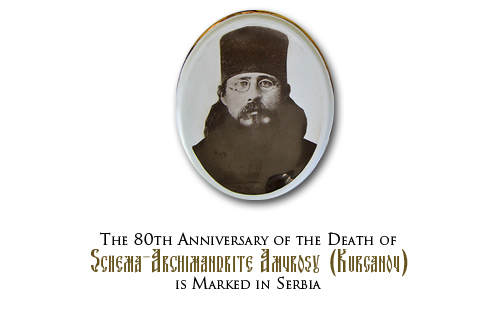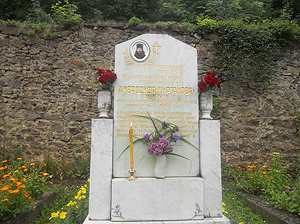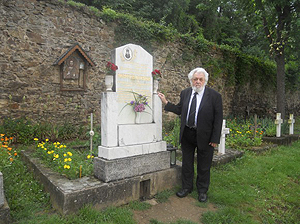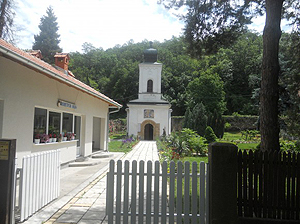
Friday, May 30, 2013, in the ancient Serbian monastery known as Milkovo, near the city of Svilajnac, on the Morava River, marked the eightieth anniversary of the blessed repose of the eminent spiritual father of the Russian diaspora, Schema-Archimandrite Amvrosy (Kurganov).��
 After the celebration of Divine Liturgy for the Departed, a full pannikhida was performed over the grave of the Abbot of Milkovo, headed by Archimandrite Dosifej, spiritual leader of the Grgeteg Monastery on Fruska Mountain in Serbia, who comes to Milkovo every year for this anniversary. After the service, Subdeacon Andrei Tarasiev, who had come specifically for this same purpose from Belgrade, addressed the worshipers with a brief speech at the insistence and blessing of Fr Dosifej and Schema-Abbess Angelina. His parents, Protopriest Vitaly and Matushka Liudmila, often visited Milkovo in their youth and called themselves �Amvrosyites.� . After the celebration of Divine Liturgy for the Departed, a full pannikhida was performed over the grave of the Abbot of Milkovo, headed by Archimandrite Dosifej, spiritual leader of the Grgeteg Monastery on Fruska Mountain in Serbia, who comes to Milkovo every year for this anniversary. After the service, Subdeacon Andrei Tarasiev, who had come specifically for this same purpose from Belgrade, addressed the worshipers with a brief speech at the insistence and blessing of Fr Dosifej and Schema-Abbess Angelina. His parents, Protopriest Vitaly and Matushka Liudmila, often visited Milkovo in their youth and called themselves �Amvrosyites.� .
After the pannikhida, there was a memorial luncheon in the monastery refectory, prepared by the kind nuns of this holy monastery. This important date was thus marked humbly but movingly.
What did Abbot Amvrosy do to merit such attention?
When you speak the name of Archimandrite Amvrosy to local pious Serbs, their first thought is that his spiritual son was Toma Strbulovic, who was to become the renowned Elder Tadej. Russians also, not only in Serbia but throughout the world, recall that here in Milkovo, under Abbot Amvrosy, the great saint of the Russian diaspora, St John of Shanghai and San Francisco, was first tonsured to monasticism. But few know what the seven �Milkovo years� of Fr Amvrosy actually mean for the Orthodox Slavic world. For this reason we will review his life.
 Vladimir Kurganov was born in a hereditary priestly family in the town of Govorovo, Saransk oblast, on January 1/14, 1894. Finishing the local parish school, then seminary in Penza, he went on to study history and philosophy in Warsaw. His spiritual guide, Fr Konstantin Koronin, introduced him to Archimandrite Veniamin (Fedchenko), in the city of Tver, who was to play a big role in his spiritual life. Vladimir Kurganov was born in a hereditary priestly family in the town of Govorovo, Saransk oblast, on January 1/14, 1894. Finishing the local parish school, then seminary in Penza, he went on to study history and philosophy in Warsaw. His spiritual guide, Fr Konstantin Koronin, introduced him to Archimandrite Veniamin (Fedchenko), in the city of Tver, who was to play a big role in his spiritual life.
War in 1914, the Front and More Studies in Moscow.
Thanks to Fr Veniamin, he participated in the First All-Russian Council in 1917, where he was able to hear the speeches of Archbishop Anthony (Khrapovitsky) of Volhynia, who would play an exceptional role in his choice of a monastic life. It was no accident that it was then that he decided to �leave the world,� and so he headed for Optina Hermitage. But the young Volodya, not yet mature enough for the life of a monk, was by the Lord�s will subjected to many tribulations. Civil War broke out, he returned to his native Govorovo, then Poltava, Moscow, he joined the ranks of the White Army. Near Kiev he suffered a serious chest wound, contracted typhus, was evacuated through Crimea with General Vrangel�s army to Constantinople, where he helped at a military hospital and served as an acolyte in the church at the Russian consulate.
His fate was inseparably bound to that of now-Metropolitan Anthony of Kiev and Galicia, who at the time ordained him subdeacon, and suggested that he move with the other refugees to Serbia.�
 The pious young Vladimir found himself in Petkovica Monastery, again to his spiritual father, now-Bishop Veniamin and his �Russian� monastery, and on March 22/April 4, 1923, was tonsured a monk with the name Amvrosy. Metropolitan Anthony, sensitive to the needs of young souls, quickly saw the spiritual potential of Monk Amvrosy, which was attested to by the fact that he made a special trip to Petkovica to ordain Amvrosy as a hierodeacon in July of that year. That year turned out to be a significant one for Fr Amvrosy�on October 14-28, Archbishop Feofan (Bystrov) of Poltava ordained him to the monastic priesthood. The pious young Vladimir found himself in Petkovica Monastery, again to his spiritual father, now-Bishop Veniamin and his �Russian� monastery, and on March 22/April 4, 1923, was tonsured a monk with the name Amvrosy. Metropolitan Anthony, sensitive to the needs of young souls, quickly saw the spiritual potential of Monk Amvrosy, which was attested to by the fact that he made a special trip to Petkovica to ordain Amvrosy as a hierodeacon in July of that year. That year turned out to be a significant one for Fr Amvrosy�on October 14-28, Archbishop Feofan (Bystrov) of Poltava ordained him to the monastic priesthood.
And so began the lamentably-short decade of Fr Amvrosy�s service to the Lord and His people. With the blessing of Metropolitan Anthony, he spent two years in Bulgaria reestablishing a Russian monastery near the city of Yambol, and at the suggestion of Vladyka Anthony, on January 24/February 4, 1926, was ordained a hegumen in the ancient Serbian monastery of Milkovo, 120 kilometers from the spiritual center of the Russian diaspora, Belgrade.
The monastery where Fr Amvrosy and a few novices went to was in terrible disrepair. And then a miracle happened: through the podvigi and labors of the young abbot, a Russian and Serbian contingent of thirty monks came together there, monastic life was established, and magnificent divine services in the monastic cycle began, and Milkovo became a genuine spiritual hearth.
According to many of his spiritual children, Abbot Amvrosy conquered everyone�s favor and lent his guidance with all-forgiving love, his ascetic life and fatherly benevolence. Despite the illness he suffered (the lingering chest wound eventually led to tuberculosis), he himself performed many tasks: he led divine services, singing on the kliros, teaching the monks to paint icons, constantly attending the labors of his brethren and his continuing spiritual lessons. According to Abbot Tadej, he forgave all except those who made accusation against his brother monastic. Hieromonk Feofan (Shishmanov) once said to the author of these lines that he had once made a critical comment about one of his novices. The abbot then refused to give him his blessing that day, and since this had not been the first time, he gave Feofan penance of fifty prostrations, saying he would be making them alongside the guilty novice! �He is pounding the floor, I am pounding the floor right next to him, both of us were in tears!� concluded the future Archimandrite Feofan.
The great but secretive ascetic did not spare himself, hiding his illnesses from everyone and avoiding no labors (for instance, in the construction of the Russian-style bath). His example, his teachings drew not only future monks but pilgrims from all over, wherever Russian refugees lived. The monastery was visited by Metropolitan Anthony, Bishop Tikhon, Bishop Nikolai and Archbishop Feofan of Kursk with the Kursk-Root Icon of the Mother of God "of the Sign.�
 This earnest service by all the monks also drew the attention of the local populace, so divine services would frequently be performed not in the church, but in the churchyard�� This earnest service by all the monks also drew the attention of the local populace, so divine services would frequently be performed not in the church, but in the churchyard��
Over his seven years as abbot at Milkovo, Fr Amvrosy gathered and guided an enormous number of young men thirsting for spiritual direction. Among those tonsured in Milkovo were St John (Maximovich) of Shanghai; future hierarchs Anthony (Senkevich) of Los Angeles; Anthony (Medvedev) of San Francisco and Archimandrite Kyprian (Kern), Professor at St Sergius Theological Institute in Parish. It was here that the following received their first monastic lessons: Bishop Leonty of Geneva; Archbishop Anthony (Bartoshevich) of Western Europe; Archimandrite Feofan (Shishmanov); Archimandrite Nikandor (Belyakov), Archimandrite Zosima (Valyaev); Hegumen Luke (Rodionov), who succeeded Fr Amvrosy; Ivan (Philipp) Gardner, scholar of ancient Russian liturgical music, and many others. Russian youth made frequent pilgrimages to Milkovo, where, despite the great responsibility of abbacy, Archimandrite Amvrosy always found time for edifying discussions and words of wisdom. But he was very strict with those who came to the monastery as though to a picnic, that is, to swim in the Morava and miss divines services. These would be told to leave the monastery�
Preserved for posterity was Metropolitan Anthony�s� expressed sentiment that those closest in spirit to him were Fr John (Maximovich) and Archimandrite Amvrosy.
The enormous stress places upon him, the unwillingness to recuperate from illness or take care of his health finally took their toll on Fr Amvrosy. In early 1933, he caught a cold in the frigid church, and he began to cough blood. But, understanding his situation well, he agreed to go to a Belgrade hospital, and then only a month later begged to be returned to his brethren in Milkovo. By the beginning of Great Lent, he was unable to read the Canon of St Andrew of Crete, spent the last of his strength celebrating Divine Liturgy on the Sunday of the Triumph of Orthodoxy, and retired to his bed.
By May his health flagged so much that everyone knew that the end of his earthly life was nigh. Making his farewell with each of the monks and accepting the Great Schema, he quietly went to the Lord on the evening of May 17/30, 1933.
Metropolitan Anthony himself performed the funeral, along with a host of clergymen. The great abbot was buried at the monastery walls behind the church altar, and with his prayers preserves the monastery�s monastics to this day�now, however, nuns, since Milkovo became a convent in 1956.
Holy Abbot Amvrosy, pray to God for us!
Subdeacon Andrei Tarasiev�
Belgrade, Serbia
|